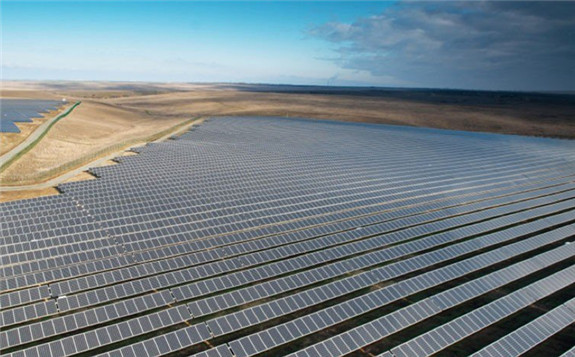
The Skeleton Creek wind, solar, and energy storage projects were announced this week as the Western Farmers Electric Cooperative (WFEC) revealed it had signed a Power Purchase Agreement (PPA) with NextEra Energy Resources for the power from the project.
The co-located project is the first of its kind announced in the United States’ Southwest Power Pool – the electric grid region that includes 14 states in the central United States, and which covers 546,000 square miles (over 1,400,000 square kilometres).
The project will consist of three separate projects and will come online in two phases. The first phase, Skeleton Creek Wind – which had already been announced – will be a 250 MW onshore wind farm which is expected to begin operations by the end of 2019.
The second phase will consist of Skeleton Creek Solar – a 250 MW solar energy project – and Skeleton Creek Storage – a 200 MW, 4-hour battery energy storage project – both of which are expected to come online and begin operations by the end of 2023.
“Pairing renewable energy with battery storage presents a tremendous advantage for Western Farmers and its customers,” said John Ketchum, president and chief executive officer of NextEra Energy Resources.
“With this combined facility, we can optimize and maximize the amount of low-cost, emissions-free electricity we provide, while helping Western Farmers diversify its power generation portfolio, reduce its dependence on fossil fuels and set a great example for others to follow.”
“At Western Farmers, we are always looking for ways to better serve our customers with reliable, low-cost and environmentally-friendly energy,” added Gary Roulet, chief executive officer for WFEC.
“With the price of wind and solar energy lower than ever, we are now able to pair it with battery storage to make more affordable, renewable energy* available to customers for more hours of the day – even when the wind isn’t blowing and the sun isn’t shining.”
NextEra’s new Skeleton Creek tribrid solar + wind + storage project dwarfs a similar tribrid deal NextEra signed with Portland General Electric in February, set for completion by the end of 2021, which will see the co-location of 300 MW of wind, 50 MW of solar, and 30 MW/120 MWh of energy storage.
The project, the Wheatridge Renewable Energy Facility, is still set to be the first tribrid project of this scale in North America, though will now be surpassed within two years.
“We’re moving aggressively to integrate smart grid technologies and renewable energy to give customers affordable, clean, low-carbon energy,” said Maria Pope, president and CEO of Portland General Electric. “Wheatridge will be a model for integrating renewable generation and storage to cost-effectively reduce emissions while maintaining a reliable grid.”
Importantly, NextEra Energy Resources is putting into practice a design which, until recently, has been overshadowed by the spectre of potential complications.
“Optimizing one factor is pretty easy, two is hard, three is complicated, and heck, add storage duration as a fourth question,” said Daniel Finn-Foley, an analyst at Wood Mackenzie Power & Renewables. “Utilities do entire portfolio analyses to design their systems around all these factors; NextEra is now doing it at the project level.”
Co-locating wind and solar is not new but adding energy storage – as Finn-Foley hints at – increases the complexity of the project significantly.
That it has taken this long is due in part to the cost of energy storage projects, but with these costs tumbling dramatically over the last year or so, it is no surprise that ambitious renewable energy utilities like NextEra are looking to utilise more energy storage options at their renewable sites.